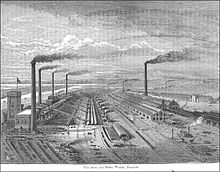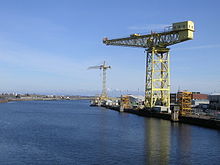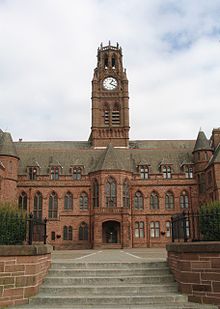- Barrow-in-Furness
-
For the larger local government district, see Barrow-in-Furness (borough).
Coordinates: 54°06′39″N 3°13′34″W / 54.1108°N 3.2261°W
Barrow-in-Furness 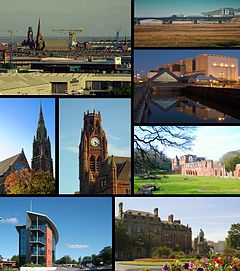
Top to Bottom, left to right: Central Barrow with the skyline of Blackpool also visible, Walney Bridge, The Dock Museum and Devonshire Dock Hall, St. Mary of Furness Roman Catholic Church, Barrow Town Hall, Furness Abbey, Emlyn Hughes House and Ramsden Square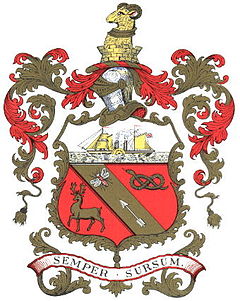
Coat of arms of Barrow in Furness
 Barrow-in-Furness shown within Cumbria
Barrow-in-Furness shown within CumbriaPopulation 2001 Census
Town 59,182
Borough 71,981OS grid reference SD198690 - London 222 mi (357 km) District Barrow-in-Furness Shire county Cumbria Region North West Country England Sovereign state United Kingdom Post town BARROW-IN-FURNESS Postcode district LA13-LA16 Dialling code 01229 Police Cumbria Fire Cumbria Ambulance North West EU Parliament North West England UK Parliament Barrow and Furness List of places: UK • England • Cumbria Barrow-in-Furness (/ˈbærɵ ɪn fərˈnɛs/, locally /ˈbærɵ ɪn ˈfɜrns/; commonly known as Barrow) is an industrial town and seaport which forms about half the territory of the wider Borough of Barrow-in-Furness in the county of Cumbria, England. It lies 49 mi (79 km) north of Liverpool, 59 mi (95 km) northwest of Manchester and 54 mi (87 km) southwest from the county town of Carlisle. The town is situated at the tip of the Furness peninsula bordered by Morecambe Bay, the Duddon Estuary and the Irish Sea. It has a population of 59,182, whilst the wider borough is home to 71,981 people.[1]
In the Middle Ages, Barrow was a small hamlet within the parish of Dalton-in-Furness. Furness Abbey, on the outskirts of the modern day town, controlled the local economy before its dissolution in 1537. Even as late as 1843 there were still only 32 dwellings including two pubs. The iron prospector Henry Schneider arrived in Furness in 1839 and, with other investors, opened the Furness Railway in 1846 to transport iron ore and slate from local mines to the coast. Further hematite deposits were discovered in 1850, of sufficient size to develop factories for smelting and exporting steel. By the late 19th century, Barrow was home to the largest steelworks in the world.[2]
Barrow's location and the availability of steel allowed the town to develop into a significant producer of naval vessels, a shift that was accelerated during World War I and the local yard's specialisation in submarines. The original iron- and steel- making enterprises closed down after World War II, leaving Vickers boat building factory as Barrow's main industry and employer. The Royal Navy flagships HMS Hermes, HMS Invincible and HMS Albion as well as all four Vanguard class submarines, which carry Trident nuclear weapons, were manufactured at the facility. From the 1960s the shipyard increasingly specialised in the construction of nuclear-powered submarines. However with the end of the Cold War and subsequent decrease in military spending the town suffered high unemployment through lack of contracts, despite this the shipyard remains operational and the only submarine production facility in the UK.[3]
Contents
Toponymy
The name was originally that of an island—the name 'Barrai' can be traced back to 1190. This was later renamed 'Old Barrow', recorded as Oldebarrey in 1537, and Old Barrow Insula and Barrohead in 1577. The island was then joined to the mainland and the town took its name. The name itself seems to mean 'island with promontory', combining British barro- and Old Norse ey, but it is more likely that Scandinavian settlers simply accepted barro- as a meaningless name, and so added an explanatory Old Norse second element.[4]
Nicknames
During the late 19th and early 20th centuries Barrow was nicknamed the 'English Chicago' because of the sudden and rapid growth in its industry, economic stature and overall size.[5] More recently the town has been dubbed the 'Capital of blue-collar Britain' by The Daily Telegraph as a result of its strong working class identity,[6] Barrow is also often jokingly referred to as being located at the end of the longest cul-de-sac in the country (because of its relatively isolated location at the tip of the Furness peninsula).
History
Early history
In the Middle Ages the Furness peninsula was controlled by the Cistercian monks of the Abbey of St Mary of Furness, known as Furness Abbey. This was located in the 'Vale of Nightshade', now on the outskirts of the town.[7] Originally founded for the Savigniac order, it was built on the orders of King Stephen of England in 1123. Soon after the abbey's foundation the monks discovered iron ore deposits, later to prove the basis for the Furness economy. These thin strata, close to the surface, were extracted through open cut workings,[8] which were then smelted by the monks in small bloomeries (early furnaces).[9] The proceeds from mining, along with agriculture and fisheries, meant that by the 15th century the abbey had become the second richest and most powerful Cistercian abbey in England, after Fountains Abbey in Yorkshire.[10] However, Barrow itself was just a hamlet in the parish of Dalton-in-Furness on the Furness peninsula, reliant on the land and sea for survival. Small quantities of iron and ore were exported from jetties on the channel separating the village from Walney Island. Amongst the oldest buildings in Barrow are several cottages and farm houses in Newbarns (now a ward of the town) which date back to the early 17th century. Even as late as 1843 there were still only 32 dwellings including two pubs.[11]
19th century
In 1839 Henry Schneider arrived as a young speculator and dealer in iron, and he discovered large deposits of haematite in 1850. He and other investors founded the Furness Railway, the first section of which opened in 1846 to transport the ore from the slate quarries at Kirkby-in-Furness and haematite mines at Lindal-in-Furness to a deep water harbour near Roa Island.[12] The crucial and difficult link across Morecambe Bay between Ulverston and Carnforth on the main line was promoted, as the Ulverston and Lancaster Railway, by a group led by John Brogden and opened in 1857. It was promptly purchased by the Furness Railway[13] .[14]
The docks built between 1867 and 1881 in the more sheltered channel between the mainland and Barrow Island replaced the port at Roa Island. The increasing quantities of iron ore mined in Furness were then brought to Barrow to be transported by sea.
The investors in the burgeoning mining and railway industries decided greater profits could be made by smelting the iron ore into steel, and then exporting the finished product. Schneider and James Ramsden, the railway's general manager, erected blast furnaces at Barrow that by 1876 formed the largest steelworks in the world.[15] Its success was a result of the availability of local iron ore, coal from the Cumberland mines and easy rail and sea transport. The Furness Railway, who counted local aristocrats William Cavendish, 7th Duke of Devonshire and the Duke of Buccleuch as investors, kick-started the Industrial Revolution on the peninsula. The railway brought mined ore to the town, where the steelworks produced large quantities of steel. It was used for shipbuilding, and derived products such as rails were also exported from the newly built docks.[12] Thus Barrow's population, only 700 in 1851, reached 10,000 by 1864 and 47,000 by 1881, forty years after the railway was built.
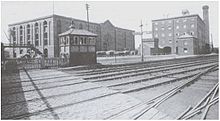 Cornmill Crossing in 1895 (one of many stations of the Furness Railway), a retail park now exist on the site
Cornmill Crossing in 1895 (one of many stations of the Furness Railway), a retail park now exist on the site
The sheltered strait between Barrow and Walney Island was an ideal location for the shipyard. The first ship to be built, the Jane Roper, was launched in 1852; the first steamship, a 3,000-ton liner named Duke of Devonshire, in 1873. Shipbuilding activity increased, and on 18 February 1871 the Barrow Shipbuilding Company was incorporated. Barrow's relative isolation from the United Kingdom's industrial heartlands meant that the newly formed company included several capabilities that would usually be subcontracted to other establishments. In particular, a large engineering works was constructed including a foundry and pattern shop, a forge, and an engine shop. In addition, the shipyard had a joiners' shop, a boat-building shed and a sailmaking and rigging loft.[16]
During these boom years, Ramsden proposed building a planned town to accommodate the large workforce which had arrived. There are few planned towns in the United Kingdom, and Barrow is one of the oldest. Its centre contains a grid of well-built terraced houses, with a tree-lined road leading away from a central square. Ramsden later became the first mayor of Barrow,[17] which was given municipal borough status in 1867, and county borough status in 1889.[18] The imposing red sandstone Town Hall, designed by W.H. Lynn, was built in a neo-gothic style in 1887.[19] Prior to this, the borough council had met at the railway headquarters: the railway company's control of industry extended to the administration of the town itself.
The Barrow Shipbuilding Company was taken over by the Sheffield steel firm of Vickers in 1897, by which time the shipyard had surpassed the railway and steelworks as the largest employer and landowner in Barrow. The company constructed Vickerstown, modelled on George Cadbury's Bournville, on the adjacent Walney Island in the early 20th century to house its employees.[20] It also commissioned Sir Edwin Lutyens to design Abbey House as a guest house and residence for its managing director, Commander Craven.[21]
20th century
By the 1890s the shipyard was heavily engaged in the construction of warships for the Royal Navy and also for export. The Royal Navy's first submarine, Holland 1, was built in 1901,[22] and by 1914 the UK had the most advanced submarine fleet in the world, with 94% of it constructed by Vickers. Vickers was also famous for the construction of airship hangars during the early 20th century.[23] Well-known ships built in Barrow include the Mikasa, Japanese flagship during the 1905 Russo-Japanese War, the liner SS Oriana and the aircraft carriers HMS Invincible and HMAS Melbourne. Thousands of local men fought abroad during World War I, 616 were ultimately died in action.[24]
During World War II, Barrow was a target for the German air force looking to disable the town's shipbuilding capabilities (see Barrow Blitz).[25] The town suffered the most in a short period between April and May 1941. During the war, a local housewife, Nella Last, was selected to write a diary of her everyday experiences on the home front for the Mass-Observation project. Her memoirs were later adapted for television as Housewife, 49 starring Victoria Wood. The difficulty in targeting bombs meant that the shipyards and steelworks were often missed, at the expense of the residential areas. Ultimately, 83 people were killed and 11,000 houses in the area were left damaged. To escape the heaviest bombardments, many people in the central areas left the town to sleep in hedgerows with some being permanently evacuated. Barrow's industry continued to supply the war effort, with Winston Churchill visiting the town on one occasion to launch the aircraft carrier HMS Indomitable.[26] Besides the dozens of civilians killed during World War II, some 268 Barrovian men were also killed whilst in combat.[24]
The end of the war saw the beginning of a long decline of mining and steel-making as a result of overseas competition and dwindling resources. The Barrow ironworks closed in 1963,[27] three years after the last Furness mine shut. The by then small steelworks followed suit in 1983,[28] leaving Barrow's shipyard as the town's principal industry. From the 1960s onwards it concentrated its efforts in submarine manufacture, and the UK's first nuclear-powered submarine, HMS Dreadnought was constructed in 1960. HMS Resolution, the Swiftsure-class, Trafalgar-class and Vanguard-class submarines all followed.
The end of the Cold War in 1991 marked a reduction in the demand for military ships and submarines, and the town continued its decline. The shipyard's dependency on military contracts at the expense of civilian and commercial engineering and shipbuilding meant it was particularly hard hit as government defence spending was reduced dramatically.[29] As a result, the workforce shrank from 14,500 in 1990 to 5,800 in February 1995,[30] with overall unemployment in the town rising over that period from 4.6% to 10%.[3] The rejection by the VSEL management of detailed plans for Barrow's industrial renewal in the mid-to-late 1980s remains controversial.[31] This has led to renewed academic attention in recent years to the possibilities of converting military-industrial production in declining shipbuilding areas to the offshore renewable energy sector.[32]
21st century
In the 2002 Barrow-in-Furness Legionnaires' disease outbreak, 172 people were reported to have caught the disease, of whom seven died. This made it the fourth worst outbreak in the world in terms of number of cases and sixth worst in terms of deaths (see list of Legionnaires' disease outbreaks). The source of the bacteria was later found to be steam from a badly maintained air conditioning unit in the council-run arts centre Forum 28.[33]
At the conclusion of the inquest into the seven deaths, the coroner for Furness and South Cumbria criticised the council for its health and safety failings.[34] In 2006, council employee Gillian Beckingham and employer Barrow Borough Council were cleared of seven charges of manslaughter, but both admitted breaching the Health and Safety at Work Act. Beckingham, the council senior architect ultimately responsible for health and safety at the centre, was fined £15,000 and the authority £125,000.[35] The borough council was the first public body in the country to face corporate manslaughter charges.[36]
Regeneration
The Waterfront
Main article: The Waterfront Barrow-in-FurnessMany areas of the town have seen regeneration in the 1990s, and on 28 September 2007 Barrow's £200 million Dockland regeneration project began. Due to be completed by 2020, the project includes a new 'Barrow Marina Village' which will incorporate an £8 million 400-berth marina, 600 houses, restaurants, shops, hotels and a new state of the art bridge across Cavendish Dock. A large watersports centre is also being built, with the possibility of a cruise ship terminal. Some cruise ships are already scheduled to dock in Barrow, mainly for tourists to visit the Lake District, although there is no official cruise ship terminal yet. Dozens of cruise ships have visited the Port of Barrow in recent years.[37]
Shipyard
The shipyard has been given planning permission to construct a new assembly hall, dubbed 'Son of DDH' in a reference to the existing Devonshire Dock Hall shipbuilding facility. However, the building will not now be used for the construction of aircraft carrier sections as the carrier build will now take place in Glasgow. John Hutton, former MP for Barrow, has however, promised that all seven Astute Class submarines will be built at the shipyard.[38] Following a decline in employment levels at the shipyard over the last 20 years, BAE Systems recently announced that the current workforce of 3,835 could soon grow to 5,000, although this is still only a third of the 14,000 employed in the 1980s.[39]Proposed bridges
A second bridge to Walney Island from mainland Barrow is planned to relieve congestion and as an aid to 24-hour access for the emergency services, most of which are based on the mainland.For many years there have been discussions on the possible construction of bridges across Morecambe Bay and the Duddon Estuary, leading to the Build Duddon and Morecambe Bridges party contesting national elections in the borough of Barrow and Furness, receiving 409 (1.1%) votes in the 2005 general election.[40]
Morecambe Bay Bridge
The controversial idea of a 12 miles (19 km) long road bridge connecting Barrow to the Lancashire coast across Morecambe Bay has long been proposed. More recently the design is said to have become more 'green' : if built, it would become one of the world's longest bridges and it is hoped that it might be capable of powering hundreds of thousands of home via such renewable sources as tidal power.Duddon Estuary Bridge
A smaller bridge (some 3 km long) crossing the Duddon Estuary linking Askam and Millom would improve transport links to the area, cutting journey times from Barrow to parts of West Cumbria, but would require considerable finance. There has also been talk of building a road and rail tunnel under the Duddon instead of a bridge.[41] There has been increased talk of this bridge since the announcement of Kirksanton on the North side of the Duddon Estuary being shortlisted as a site for a new nuclear power station.[42]Government
See also: Category:Politics of Barrow-in-FurnessBarrow is the largest town in the Borough of Barrow-in-Furness[43] and the largest settlement in the peninsula of Furness. The borough is the direct inheritor of the municipal and county borough charters given to the town in the late 19th century.[44] Historically it is part of the Hundred of Lonsdale 'north of the sands' in the historic county boundaries of Lancashire.[45] Since the local government reforms enacted in England in 1974 the town has been within the administrative county of Cumbria. It still forms a part of the Duchy of Lancaster. The Barrow-in-Furness Borough Council forms the 'lower' tier of local government under Cumbria County Council.[46] The town, along with Walney Island, is unparished and forms the bulk of the wards which make the entire borough's area. The Mayor and Deputy Mayor of Barrow are elected annually, and hold the roles of Chairman and Vice Chairman of Barrow-in-Furness Borough Council.[47] The borough and fomer county borough of Barrow-in-Furness have been served by 105 mayors, beginning with Sir James Ramsden in 1867 and continuing through to incumbent 2011 mayor Rory McClure.[44] Between 2006 and 2011 no party held an overall majority of council seats, but in the 2011 local election, the Labour Party gained overall control of the council.
The Barrow-in-Furness UK Parliament constituency first came into existence during the 1885 United Kingdom general election, with David Duncan of the Liberal Party becoming the first MP for the town. In 1983, the constituency was expanded to include several commuter towns such as Dalton-in-Furness and Ulverston and was renamed Barrow and Furness. Barrow and Furness has largely been a Labour seat since then. In the 2010 general election, John Woodcock was elected as MP for the constituency.
Council/ Electoral wards of Barrow-in-Furness Barrow Island | Central | Hawcoat | Hindpool | Newbarns | Ormsgill | Parkside | Risedale | Roosecote | Walney North | Walney South
Geography
Barrow-in-Furness is situated at the tip of the Furness peninsula on the north-western edge of Morecambe Bay. The town centre and major industrial areas sit on a fairly flat coastal shelf, with a gentle incline leading away from the coast. Ten miles to the north-east is the southern boundary of the Lake District National Park.
Destinations from Barrow-in-Furness 
Irish Sea Askam-in-Furness, Duddon Estuary, Millom Dalton-in-Furness, Ulverston 
Irish Sea, Isle of Man 
Leece, Morecambe Bay, Bolton-le-Sands, Carnforth  Barrow-in-Furness
Barrow-in-Furness 

Irish Sea Morecambe Bay, Fleetwood, Blackpool Morecambe Bay, Morecambe, Lancaster Islands
Main article: Islands of FurnessThe town is sheltered from the Irish Sea by Walney Island, a 14 mile (22.5 km) long island connected to the mainland by the bascule type Jubilee bridge. About 13,000 live on the isle's various settlements, mostly in Vickerstown, which was built to house workers in the rapidly expanding shipyard. Another significant island which lay in the Walney Channel was Barrow Island, but following the filling of the channel to create land for the yard it is now directly connected to the town. Other islands which lie close to Barrow are Piel Island, whose castle protected the harbour from marauding Scots, Sheep Island, Roa Island and Foulney Island.
Climate
Climate data for Barrow-in-Furness, England, United Kingdom Month Jan Feb Mar Apr May Jun Jul Aug Sep Oct Nov Dec Year Record high °C (°F) 13
(55)14
(57)19
(66)22
(72)27
(81)31
(88)33
(91)33
(92)27
(80)23
(74)16
(61)14
(57)23
(73)Average high °C (°F) 7
(44)8
(46)9
(49)12
(53)15
(59)17
(62)19
(66)19
(67)17
(63)14
(57)10
(50)7
(45){{{year high C}}}
(55)Average low °C (°F) 4
(39)4
(39)4
(40)6
(43)8
(47)11
(52)13
(56)13
(56)12
(53)9
(49)7
(44)4
(39){{{year low C}}}
(46)Record low °C (°F) −10
(14)−9
(16)−9
(15)−4
(24)−2
(29)2
(36)4
(39)3
(37)0
(32)−5
(23)−7
(20)−11
(12)−4
(25)Precipitation mm (inches) 71.1
(2.80)67.3
(2.65)63.5
(2.50)54.1
(2.13)55.1
(2.17)61.5
(2.42)56.4
(2.22)68.3
(2.69)86.1
(3.39)110.5
(4.35)91.9
(3.62)85.3
(3.36)871
(34.3)Source: MSN Weather[48] Demographics
Population (2010 est.)[49] Total 70,700 of which: Male 34,800 Female 35,800 by age: 0-14 15-74 75+ 11,800 55,300 3,600 Population
Barrow's population increased from the low thousands in the early 19th century to 60,000 in less than twenty years. Since the start of the 20th century the population of the town has gradually diminished to just under 60,000. The Barrow council district, which includes the surrounding area, has a population of 71,980 according to the most recent census, placing it 326th out of the 376 local authorities in England and Wales (however the population density of 900 /km2 (2,300 /sq mi) ranks 147th out of 376).[50] Barrow-in-Furness can be regarded as the largest town in Cumbria, Carlisle in the north of the county having city status. It is also the 15th largest settlement in North West England and the 142nd largest in the United Kingdom. People from Barrow are known as Barrovians.[51]Population of the borough in the 19th century Year 1801 1811 1831 1851 1861 1871 1881 1891 Population[52] 1,958 2,078 2,702 4,684 22,513 40,343 58,172 62,694 Population of the borough in the 20th century Year 1901 1911 1921 1931 1941 1951 1961 1971 1981 1991 2001 Population[52] 67,354 72,360 73,394 74,447 75,509 76,619 75,902 72,192 72,645 73,704 71,979 Ethnicity
2009 estimates state 95.9% of Barrow's population as indigenous White British, and ethnic minority populations in Barrow stand at 4.1%, the breakdown of which is shown in the table below.[53][54] The first people to settle in what is now Barrow were the Celts and Scandinavians followed by the Cornish although in the late 19th century there was mass immigration from Scotland and other parts of England. Thus the distinction between these immigrants and the previous native population is not clear from the table below. Besides a sizeable South Asian community, Barrow is also home to significant Chinese,[54] Filipino,[55] Kosovan,[56] Polish[57] and South African[58] populations.Ethnic Group Population Percentage of
local populationWhite British 68,000 95.9% Other White 1,300 1.9% South Asian 600 0.8% Mixed Race 500 0.7% Black 200 0.3% Chinese 100 0.2% Other 100 0.2% Country of birth
The 2001 UK census states that 93.56% (67,345) of the borough's population was born in England, 2.86% (2,061) in Scotland, 0.63% (451) in Wales, 0.68% (486) in Northern Ireland, 0.32% (231) in the Republic of Ireland and 0.06% (43) in the Channel Islands. 0.61% (441) of the town's 2001 population were born in the rest of Europe, although numbers are likely to be currently much higher, due to significant immigration from Eastern Europe (in particular Poland) to Barrow. Barrow has the eighth fastest growing non-indigenous white community of any town or city in the country, at 15.9% growth between 2004 and 2005.[59] Barrow has also seen a huge increase with other ethnic minority groups, and the growth rate for most groups is around 2 times faster than national average.[60] The Asian born population represented 0.50% (363) of Barrow's population, 0.35% (253) of people were born in North America, 0.23% (177) of people were born in Africa, 0.12% (83) of people were born in Oceania, 0.04% (27) of Barrovians were born in Latin America, and 0.02% (11) of people were born in some other place.[58]Religion
See also: List of places of worship in Barrow-in-FurnessIn the 2001 census 58,322 Barrovians stated themselves as being Christian. People stating no religion or chose not to state numbered 13,234 combined. The second largest religion in Barrow is Islam with a population of 182 Muslims. Other religious populations are as follows: 72 Buddhists, (nearby Conishead Priory, the first Kadampa Buddhist centre in the west, is home to around 100 Buddhists[61]) 46 Hindus, 25 Jews and 96 with another religion.[50]
Other
Out of the 56,987 age 16 or over in 2001, 43.81% were married, 26.26% single, 9.57% widowed, 9.36% divorced, 8.98% re-married and 2.01% separated (but still legally married).[62] The Total Fertility Rate of Barrow is 1.54, lower than North West England's rate (1.66) and England's (1.65).[63] 162 Barrovians were working in the Armed Forces in 2001[64] Barrow has one of the highest percentages of people on benefits in the entire United Kingdom, at 23% of the working age, it is much higher than England's average of 14%.[65]Economy
Shipyard and port
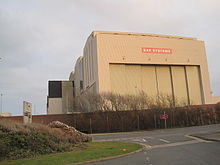 The huge doors of the west entrance to Devonshire Dock Hall
The huge doors of the west entrance to Devonshire Dock Hall
 HMS Invincible is one of the most famous ships to have been built by Vickers in Barrow
HMS Invincible is one of the most famous ships to have been built by Vickers in Barrow
The BAE Systems Submarine Solutions shipyard at Barrow is one of the largest shipyards in Britain. It was expanded in 1986 by construction of a new covered assembly facility, the Devonshire Dock Hall (DDH), completed by Alfred McAlpine plc, on land that was created by infilling part of the Devonshire Dock with 2.4 million tonnes of sand pumped from nearby Roosecote Sands.[66] DDH is the tallest building in Cumbria at 51 m. With a length of 268 m (879 ft), width of 51 m (167 ft) and an area of 25,000 square metres (270,000 sq ft) it is the second largest shipbuilding construction complex of its kind in Europe.[67][68]
The DDH provides a controlled environment for ship and submarine assembly, and avoids the difficulties caused by building on the slope of traditional slipways. Outside the hall, a 24,300 tonne capacity shiplift allows completed vessels to be lowered into the water independently of the tide. Vessels can also be lifted out of the water and transferred to the hall.[69] The first use of the DDH was for construction of the Vanguard-class submarines, and later vessels of the Trafalgar-class submarines were also built there. The shipyard is currently constructing the Astute-class submarines the first of which was launched on 8 June 2007.[70] BAE Systems is currently studying the design of a new class of ballistic missile submarines. BAE Systems also has orders for submarine pressure domes for the Spanish Navy.[71]
BAE Systems has obtained planning permission from Barrow Borough Council for the new Central Assembly Shop dubbed 'Son of DDH' which will provide over 700 new jobs, initially in construction of a large section of the new Queen Elizabeth-class aircraft carriers. (hull lower block 3).[72][73] Despite the large fall in numbers employed by the shipyard, Barrow retains a high proportion of workers in the manufacturing industry.
The shipyard does not build submarines exclusively: it undertook fitting out and commissioning of helicopter carrier HMS Ocean in the mid-1990s (although the ship was built by Kvaerner Govan in Glasgow), and construction of Wave-class tanker Wave Knight and Albion-class amphibious assault ships HMS Albion and HMS Bulwark.
Associated British Ports Holdings owns and operates the port of Barrow which can berth vessels up to 200 m (660 ft) long and with a draught of 10 m (33 ft). Principal traffic includes the export of condensate by-product from the production of gas at the Rampside Gas Terminal, wood pulp, and locally quarried limestone which is exported to Scandinavia for use in the paper industry. The port, which has deep water access, also handles the shipment of nuclear fuels and radioactive waste for BNFL's nearby Sellafield plant.[74]
James Fisher & Sons plc, a service provider in all sectors of the marine industry and a specialist supplier of engineering services to the nuclear industry in the UK and abroad,[75] was founded in Barrow in 1847[76] and is the largest company to have its headquarters situated in Cumbria.[citation needed] Annual revenue stood at almost £90 million in 2007 (up 55% from £57 million in 2006), as well as staff numbers standing at over 1,000 worldwide, with 120 of those in the Barrow headquarters.[77]
Energy generation
 West Shore Beach at Earnse Bay with Black Combe visible in the distance
West Shore Beach at Earnse Bay with Black Combe visible in the distance
In 1985, gas was discovered in Morecambe Bay, and to this day the products have been processed onshore at Rampside Gas Terminal in south Barrow.[78] The complex is opperated jointly by Centrica and ConocoPhillips. Directly adjacent to Rampside Gas Terminal is Roosecote Power Station which was the first CCGT power station to supply electricity to the United Kingdom's National Grid. Although originally coal-fired, the station is now gas-fired.
Barrow and its wider urban area form part of 'Britain's Energy Coast',[79] and has one of the highest concentrations of wind farms in the world, the vast majority are located offshore and have been built during the early 2010s. All four of these wind farms are located off the coast of Walney Island, including the 108 turbine West Duddon Wind Farm, 102 turbine Walney Wind Farm, 30 turbine Barrow Offshore Wind Farm and 30 turbine Ormonde Wind Farm.
Sellafield and Heysham nuclear power station are also located within 25 mi (40 km) of Barrow.
Tourism
Being only around 20 minutes from the Lake District,[80] Barrow has been referred to as a 'gateway to the lakes',[81] a status which could be enhanced by the new marina complex and planned cruise ship terminal.[82] Barrow itself has several tourist attractions, including the Dock Museum. The museum tells the history of Barrow (including the steelworks industry, shipyard and Barrow Blitz), as well as offering gallery space to local artists and schoolchildren. It is built upon and around an old graving dock.[83] Barrow also has a popular indoor market, which features a food hall as well as stalls selling clothes and other goods.[84][85] Barrow has been described as the Lake District's premier shopping town, with 'big name shops mingling with small local ones',[86] and being home to Portland Walk Shopping Centre.[87] The town also features Hollywood Park - a leisure facility with restaurants, shops[86] and Cumbria's largest cinema.[88] The town also features several other retail parks (including Cornmill Crossing, Cornerhouse Retail Park, Hindpool Retail Park and Walney Road Retail Park).[89] The Park Leisure Centre is a fitness suite with a pool, set in the 45-acre (18 ha) Barrow Park.[86] Walney Island has two world renowned nature reserves (the 130 hectare South Walney Nature Reserve[90] and 650 hectare North Walney Nature Reserve).[91] The historic ruins of Furness Abbey and Piel Castle, which are both managed by English Heritage, are also popular tourist destinations. South Lakes Wild Animal Park is one of Europe's leading conservation zoos and has been voted Cumbria's best tourist attraction for five non-consecutive years, it is located within the borough of Barrow-in-Furness on the outskirts of Dalton.[92]
Other
Other major employers include the NHS, through Furness General Hospital, which employs 1,800 staff[93] and the Kimberly Clark paper mill which has 400 employees.[94] Amongst many retailers that have established themselves in Barrow, the furniture store Stollers is noted as being one of the largest shops of its kind in the UK.
Employment
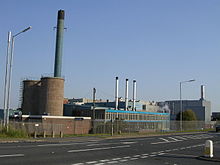 The only Kimberly-Clark paper mill in the north of England is located in Ormsgill
The only Kimberly-Clark paper mill in the north of England is located in Ormsgill
Below is a list of how many people were employed by each sector (2001 UK Census), the percentage in brackets is that of the total working population of Barrow. The + or - signs at the end indicate whether the percentge employed in that sector is slightly higher +, much higher ++, slightly lower- or much lower—than England's average.[95]
- Manufacturing - 8,087 employed (28.03% of the town's working population) ++
- Retail: 4,671 (16.19%) -
- Health and Social Work: 3,635 (12.60%) ++
- Real estate, renting and business activities: 1,852 (6.42%) –
- Construction: 1,797 (6.23%) -
- Education: 1,765 (6.12%) -
- Hotels and Catering: 1,730 (6.00%) ++
- Transport Storage and Communication: 1,490 (5.16%) -
- Public Administration and Defence: 1,427 (4.95%) -
- Other: 1,179 (4.09%) -
- Finance: 471 (1.63%) –
- Electricity, Gas and Water supply: 379 (1.31%) +
- Agriculture: 252 (0.87%) -
- Fishing: 8 (0.03%) +
Transport
See also: Category:Transport in Barrow-in-FurnessRoad
 Barrow-in-Furness railway station viewed from Abbey Road
Barrow-in-Furness railway station viewed from Abbey Road
Barrow's principal road link is the A590, linking it to Ulverston, the Lake District and to the M6 motorway.[96] Just north of Barrow is the southern terminus of the A595, linking the town to Whitehaven, Workington and eventually Carlisle.[96] The possibility of a bridge link over Morecambe Bay is occasionally raised, with feasibility studies currently underway.[97] Abbey Road is the principal road network through central Barrow, whilst Walney Bridge connects Barrow Island to Walney Island.
Bus
Bus services within the town are operated by Stagecoach North West. There is no specifically designated bus station, although many buses start and terminate their routes near the town hall. The original bus station was known for its role in a 1970s television commercial for Chewits sweets before its demolition.[98] Other services link Barrow with outlying villages as well as longer distance routes to Dalton-in-Furness, Ulverston and Kendal.Rail
Barrow-in-Furness railway station provides connections to Whitehaven, Workington and Carlisle to the north, via the Cumbrian Coast Line and to Ulverston, Grange-over-Sands and Lancaster to the east, via the Furness Line. It handles 503,800 passengers annually.[99] Barrow has a second railway station, Roose, which serves the suburb of the same name.Furness Abbey, Barrow's third main line station, closed in 1950. There was also a station on Barrow Island, used to enable workers at Vickers Limited (as it was then known) to commute directly between the shipyard and nearby towns served by the Furness Railway. This railway link was severed in 1966 when the famous cradle bridge across the docks was closed permanently for safety reasons.
Air
Barrow/Walney Island Airport operates two Beechkraft Kingair 250 aircraft which fly to various destinations every weekday, including Manchester, Bristol and Blackpool. It is owned and operated by BAE Systems (IATA airport code: BWF, ICAO: EGNL). The longest runway is almost 4,000 feet long. It is one of two airports in the county, the other being Carlisle Lake District Airport (which alongside Barrow once served as a commercial domestic airport). The nearest international airport is Blackpool International Airport, although most people from Barrow use the larger Liverpool and Manchester airports.Sea
Despite being one of the UK's leading shipbuilding centres, the Associated British Ports' Port of Barrow is only a minor port. The only ferry links are between Roa Island and Piel Island, but there are proposals to create a cruise ship terminal.[100]Sport
 Holker Street, the home of Barrow A.F.C.
Holker Street, the home of Barrow A.F.C.
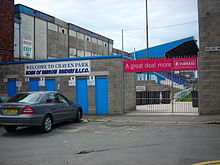 Craven Park, the current home of Barrow Raiders
Craven Park, the current home of Barrow Raiders
Barrow A.F.C.
Main article: Barrow A.F.C.Barrow A.F.C. are in the Conference National division of English football.[101] The team, founded in 1901, are nicknamed "the Bluebirds" and play their home games at the Holker Street stadium.[102] The side were members of the Football League until they were demoted in 1972.[102] In 1990, they won the FA Trophy beating Leek Town 3-0 in the final at Wembley Stadium, London.[103] Twenty years later, on 8 May 2010, Barrow repeated the feat, beating Stevenage Borough 2-1 after extra time.[104] Football players born in Barrow include England internationals Emlyn Hughes[105] and Gary Stevens,[106] as well as Harry Hadley,[107] and Vic Metcalfe.[108] Of current professional footballers, Wayne Curtis,[109] Morecambe striker, and Iran Under-20 and Hibernian winger Shana Haji[110] both hail from the town.
Holker Old Boys F.C.
Main article: Holker Old Boys F.C.Holker Old Boys, based at Rakesmoor Lane, are the town's second most successful football team, and they play in the North West Counties Football League Division One.
Barrow RLFC
Main article: Barrow RaidersRugby league is a well-established sport and the town is considered as one of the game's traditional heartlands at professional and amateur levels.[111] The professional team, Barrow Raiders, whose home games are at Craven Park, play in The Championship. In the 1950s the side played in three Challenge Cup finals, winning the last of these against Workington Town. In the 1997 reorganisation of the sport the original Barrow RLFC team merged with Carlisle Border Raiders to form Barrow Border Raiders,[112] with the word "border" later dropped. Players who were born in the town and played at a professional level include brothers Ade[113] and Mat Gardner[114] and Willie Horne.[115] The latter captained Barrow to their Challenge Cup victory and represented Great Britain at an international level. He was inducted in to the "Barrow Hall of Fame" along with former Barrow players Phil Jackson and Jimmy Lewthwaite.[116]
Motorcycle Racing
Main article: Barrow BombersBarrow-in-Furness has staged speedway racing at three venues since the pioneer days in the late 1920s. The first track was at Holker Street. This venue had a revival for a short spell in the early-to-mid 1970s. In 1930 the sport moved to Little Park but this a somewhat hazy venue. The sport had a revival in 1978 at Park Avenue Industrial Estate but this was relatively short lived.
Golf
Barrow is home to two large golf clubs. Barrow Golf Club, founded in 1922, is situated in Hawcoat and covers some 6,209 yards (5,678 m) with 18 holes.[117] Furness Golf Club founded in 1872 is the sixth oldest golf club in England and is possibly the more famous of the two. It is located on Walney Island, just 50 yards (46 m) from the Irish Sea. It also offers an 18-hole course, a shop and other facilities.[118]
Culture
Architecture
See also: Listed buildings in Barrow-in-Furness and List of tallest buildings and structures in Barrow-in-Furness The Nan Tait Centre on Abbey Road is Grade II listed
The Nan Tait Centre on Abbey Road is Grade II listed
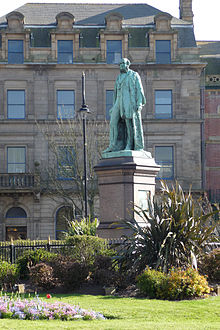 Statue of Sir James Ramsden, a founder and first mayor of Barrow
Statue of Sir James Ramsden, a founder and first mayor of Barrow
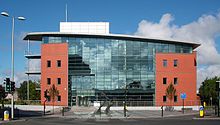 Emlyn Hughes House is a landmark 21st century office building named after local footballer and England captain Emlyn Hughes
Emlyn Hughes House is a landmark 21st century office building named after local footballer and England captain Emlyn Hughes
Barrow is one of Britain's few planned towns and has many fine buildings to show for it.[119] There are many old and distinctive buildings in the town centre, mostly from the Victorian era, such as the town hall, Barrow's main public library, the Nan Tait Centre, old Central Fire Station, Salvation Army, St. George's Church, St. Mary's Church, St. James' Church and Trinity Church. There is also an increasing number of modern office buildings as well as the shipyard's cranes and construction halls which dominate much of Barrow's skyline. Barrow has 8 Grade I listed buildings, 15 Grade II* and 249 Grade II buildings.[120]
Arts
Music
Barrow has produced several musical performers of note. They include Thomas Round, a singer and actor in D'Oyly Carte productions of Savoy Opera[121] as well as Glenn Cornick, the original bass guitarist in the rock band Jethro Tull.[122] The father of Simply Red's Mick Hucknall was born in Barrow before moving to Manchester.[123] In addition, Paul MacKenzie, bass player with 1980s Preston-based thrash metal band Xentrix, is from Barrow.[124] More recently, hip-hop DJ and record producer Aim has had considerable commercial success.[125] Les Muscutt, jazz banjo player and guitarist was born in Barrow in Furness in 1942. The family moved to East Ham in London where Les became a professional musician at age 15.Shortly after the Second World War, an Old Tyme Dancing trio was formed by Wyn Large (piano), Felix Lee (piano accordion) and Reg Powell (drums). This group entertained three or more times a week at several venues in the town and surrounding districts and was very popular with those locals who enjoyed keeping Old Tyme dancing alive. Wyn Large was succeeded by Billy Steele in the 1960s after which the group became known as the Felix Lee Trio until it disbanded in the 1970s because of the increasing age of its members.
Expressive arts
Several notables in Art and Literature have come from Barrow. Artist Keith Tyson, the 2002 Turner Prize winner, was born in nearby Ulverston, attended the Barrow-in-Furness College of Engineering and worked at the then VSEL shipyard.[126] Constance Spry, the author and florist who revolutionised interior design in the 1930s and 40s, moved to the town with her son Anthony during World War I to work as a welfare supervisor.[127] Peter Purves, later a Blue Peter presenter, began his acting career with 2 years as a member of the Renaissance Theatre Company at the town's Her Majesty's Theatre.[128] The Canteen Media & Arts Centre - known simply as "The Canteen" - and Forum Twenty Eight are the main venues for theatre.Literature
In fictional works, Barrow and Vickerstown on Walney Island featured in children's show The Railway Series, which developed into Thomas the Tank Engine, as the point where the fictional Island of Sodor connected to mainland Britain and the national rail network.[129]The great Portuguese poet Fernando Pessoa wrote a poem called "Barrow-in-Furness". His "heteronym" Álvaro de Campos lived in Barrow when he was studying ship engineering.
Media
Newspapers
There is one paid-for evening daily paper, the North West Evening Mail. There is also a weekly freesheet called the Advertiser, which is delivered to most households in the Furness area. Both are owned by independent publisher the CN Group, formerly Cumbrian Newspapers.[130]Radio
Barrow is served by one commercial radio station, The Bay, which is broadcast from Lancaster and serves the area around Morecambe Bay. Another commercial station, Abbey FM, ceased broadcasting in February 2009 when it went into administration.[131] The BBC's local radio service is BBC Radio Cumbria, who have studio facilities in the town.[132]Television
Barrow lies in the Granada TV – North West England region with the main signal coming from the Winter Hill transmitter near Bolton. There is also a relay transmitter at Millom whose signal can be received in the northern end of the town.Various television personalities were born in the district. Dave Myers was a biker born in Barrow, before he found fame as one half of television cookery duo The Hairy Bikers.[133] Karen Taylor is a TV comedienne best known for her BBC Three sketch show Touch Me, I'm Karen Taylor.[134] Steve Dixon is a newsreader for Sky News,[135] while Nigel Kneale was a well-known film and television scriptwriter.[136] Peter Purves, the sixth presenter of Blue Peter also lived and worked in Barrow for a time.
Wartime diarist and local housewife Nella Last's memoirs were adapted for television, with parts of the town used in filming. The resulting programme, Housewife, 49, written by and starring comedienne Victoria Wood, was broadcast by ITV in 2006. It won two BAFTA awards - one for Best Single Drama, the other for Best Actress (Victoria Wood).[137][138] CITV children's show The Treacle People had two villains named Barrow and Furness.[139]
Accent
Furness is unique within Cumbria and the local accent and dialect tends to be more Lancashire-oriented. Until 1974 Furness was an exclave of Lancashire. As with Liverpool for example, the Barrovian dialect has been influenced by large numbers of settlers from various regions. Up until the mid-19th century, Barrow was nothing but a small fishing village, however as the mining, steelworks and shipbuilding industries emerged and grew, thousands came to Barrow from the likes of Cornwall, Strathclyde, and Tyneside which were successful mining and shipbuilding centres already in existence. As Glaswegian and Geordie dialects mingled in Barrow numerous more migrated from Lancashire and elsewhere in England which in effect created the Barrovian dialect. In general the Barrovian dialect tends to drop certain letters (including H and T); for example holiday could be pronounced as 'oliday, with more emphasis on the letter O. Similarly the local area of Hindpool which could be pronounced "'indpool" with emphasis on the letter I. Another example is with the letter T where twenty is often pronounced "twen'y" (again an emphasis on the letters N or Y could occur); see Cumbrian dialect as well as Lancashire dialect for more information.
Nightlife
There are countless pubs and working men's clubs located across Barrow—Barrow has fourteen of the latter, one of the highest number per capita of any British town.[140] There are also many bars and clubs found primarily in Barrow Town Centre on Duke Street and Cornwallis Street. Popular venues on Duke Street include the following bars: Jeffersons, The Lounge, Bar Cairo, Yates's. Cornwallis Street – often dubbed the Gaza Strip by locals – is currently undergoing a multi-million pound renovation with the former Martinis being the flagship renovation into Club M. Other clubs on Cornwallis Street include: Kavannas, O'Sullivans and Skint. Between 2004 and 2010 Barrow was home to one of North West England's largest nightclubs, the 2,500 capacity Blue Lagoon occupied the entire hull of the former Danish ferry Princess Selandia which still remains moored at Town Quay, Buccleuch Dock.[141]
Social issues
Lifestyle
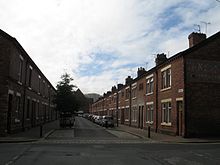 The majority of housing within the town centre is terraced, built for working class families
The majority of housing within the town centre is terraced, built for working class families
In September 2008, Barrow was named as the most working class location in the United Kingdom, based on a series of measures devised to judge the lifestyle of the people.[142] The research was carried out by Locallife.co.uk which determined that there is a fish and chip shop, working men's club, bookmakers or trade union office for every 2,917 people (Crewe, Doncaster, Wolverhampton and Preston completed the top five of 'the most working class places in Britain').[143] This is in direct contrast to the 1870s when a developing Barrow had more aristocrats per head of the population than anywhere else in the country.[142]
In 2007 Barrow was ranked as the 29th most deprived district in England (out of a total of 354), whilst 44% of wards within the town are in the most deprived fifth of English wards and areas.[144]
Health
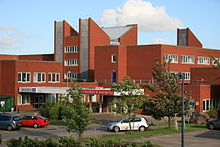 The Accident and Emergency entrance at Furness General Hospital
The Accident and Emergency entrance at Furness General Hospital
The principal hospital in Barrow is Furness General Hospital which is operated by the University Hospitals of Morecambe Bay NHS Trust and located on the outskirts of the town. As of July 2010 there are 12 NHS GP practices/doctors surgeries and 5 NHS dental surgeries in Barrow.[145] The average life expectancy for males in Barrow is 76.0 years (compared to England average of 77.7) and 80.9 years for females (again compared to national average of 81.8).[146] The 2001 UK Census showed that 63.12% of Barrovians were in good health, 23.63% in fairly good health and 13.25% in bad health. This compared to England's averages of 68.76%, 22.21% and 9.03% respectively show that in general people in Barrow are in a slightly worse state of health than England as a nation.[147] A 2009 NHS in depth publication of health in Barrow indicated that, eight years later the population of Barrow despite becoming healthier is still worse off than national average.[146] The opening statement of the publication read 'The health of people in Barrow-in-Furness is varied. Many indicators are significantly worse than the England average, including violent crime and binge drinking adults (an estimate). However, a number of indicators are similar to the average, such as GCSE achievement and healthy eating adults (an estimate), and a fifth of indicators are significantly better than average, including physically active children and adults.'[146] One fairly alarming figure is that Barrow has the tenth worst rate of incapacity benefit claimants for mental illness in the country. The NHS also identified Barrow as having significantly worse figures than England average in the fields of deprivation, child poverty, violent crime, breast feeding initiation, children's tooth decay, binge drinking adults, over 65s 'not in good health', hospital stays for alcohol related harm, male and female life expectancy, deaths from smoking and early deaths from cancer.[146] Despite this, as stated earlier the number of physically active children and adults in Barrow is significantly better than England average, whilst the town also has much lower numbers of drug misusers, diabetes sufferers and road accident injuries and deaths.[146] All other aspects of the health of Barrow's population have been stated as more or less level with nationwide average.[146]
Education
Nursery schools 13 Infant schools 5 Junior schools 5 Primary schools 15 Secondary schools 3 Private schools 1 Colleges 2 Universities
(University of Cumbria
partially sited in Barrow)1 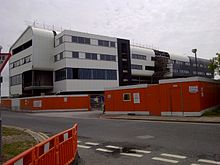 The centrepiece of Furness College's new campus under construction in June 2011
The centrepiece of Furness College's new campus under construction in June 2011
Education in the state sector is provided by the local education authority, Cumbria County Council. There are fifteen primary schools, five infant schools, five junior schools and many nurseries. Five secondary schools were created following the reorganisation of Barrow's selective tri-partite secondary education system in 1979: Parkview School, St. Bernard's Catholic High School, Walney School, Thorncliffe School and Alfred Barrow School. Three schools - Parkview, Thorncliffe and Alfred Barrow closed in August 2009 with the new Furness Academy opening in their place from early September 2009. In addition to publicly funded education, the town has one private school, Chetwynde, which has fee-paying pupils from nursery to sixth form level.[148]
In the further education sector there are two colleges.[149] Barrow-in-Furness Sixth Form College concentrates on teaching A-level subjects,[150] while Furness College specialises in vocational courses.[151]
The town's main library is the Central Library in Ramsden Square, situated near the town centre.[152] The library was established in 1882 in a room near the town hall, and moved to its current premises in 1922. A branch of the County Archive Service, opened in 1979 and containing many of the town's archives, is located within adjoining premises,[153] whilst until 1991 the library also housed the Furness Museum, a forerunner of the Dock Museum.[154] Smaller branch libraries are currently provided at Walney, Roose and Barrow Island.[152]
See also
- Borough of Barrow-in-Furness
- Barrow and Furness (UK Parliament constituency)
- List of people from Barrow-in-Furness
- Vickers Shipbuilding and Engineering
- BAE Systems Submarine Solutions
- List of ships and submarines built in Barrow-in-Furness
- Port of Barrow
- Listed buildings in Barrow-in-Furness
- List of places of worship in Barrow-in-Furness
References
- ^ Based on the population of the Borough of Barrow-in-Furnes in the 2001 UK Census, excluding the two wards of Dalton-in-Furness [1]
- ^ Barrow Steelworks
- ^ a b "Appendix on unemployment as part of report into British Aerospace PLC proposed merger with VSEL" (PDF). Competition Commission. 23 May 1995. http://www.competition-commission.gov.uk/rep_pub/reports/1995/fulltext/365a4.8.pdf. Retrieved 31 August 2007.
- ^ Mills, David (1976). The Place Names of Lancashire. London: Batsford Books. ISBN 0 7134 3248 9.
- ^ Barrow-in-Furness: kept on life support by perpetual warfare
- ^ Barrow, capital of blue-collar Britain
- ^ "Local history and heritage". Barrow Borough Council. http://www.barrowbc.gov.uk/Default.aspx?page=150#abbey. Retrieved 10 June 2007.
- ^ "Iron Mining". Industries of Cumbria. http://www.cumbria-industries.org.uk/ironmining.htm. Retrieved 10 June 2007.
- ^ "Mineral Wealth". Cumbria Fells and Dales LEADER+ Programme. http://www.fellsanddales.org.uk/trails/mineral_wealth.php#mineral_wealth. Retrieved 10 June 2007.
- ^ English Heritage. "Furness Abbey". English Heritage. http://www.english-heritage.org.uk/server/show/ConProperty.149. Retrieved 6 May 2007.
- ^ "Plan of Barrow 1843" (PDF). Barrow Borough Council. http://www.barrowbc.gov.uk/pdf/summary%20of%20plan%20areas.pdf. Retrieved 10 June 2007.
- ^ a b "History of the Furness Railway Company". The Furness Railway Trust. http://www.furnessrailwaytrust.org.uk/frco.htm. Retrieved 8 July 2007.
- ^ Marshall, J.D. (1958 reprinted 1981). Furness and the Industrial Revolution. Michael Moon, Beckermet, Cumbria. pp. 215–8. ISBN 0-904131-26-2.
- ^ Richardson, Joseph (1870). Furness Past and Present. 1 of 2. pp. 18–24.
- ^ "Barrow". Ironbridge Gorge Museum Trust. http://www.ironbridge.org.uk/about_us/ironbridge_archaeology/projects/barrow/. Retrieved 25 August 2007.
- ^ The Naval and Armaments Company Limited (1896). The Works at Barrow-in-Furness of The Naval Construction and Armaments Company Limited - Historical and Descriptive. Barrow-in-Furness: The Naval and Armaments Company Limited, partly reprinted from 'Engineering' magazine. p. 54.
- ^ "List of Mayors". Barrow Borough Council. http://www.barrowbc.gov.uk/default.aspx?page=2490. Retrieved 6 July 2007.
- ^ "History of Dalton-in-Furness". Dalton Online. Dalton Community Association. http://www.dalton-in-furness.org.uk/dalton-online/history/modern-town/modern-town-localgov.html. Retrieved 6 July 2007.
- ^ "Local History and Heritage". Barrow Borough Council. http://www.barrowbc.gov.uk/Default.aspx?page=150. Retrieved 8 July 2007.
- ^ Partridge, Frank (16 March 2006). "The Compete Guide to: England's Islands". The Independent (London: Independent News & Media). http://travel.independent.co.uk/uk/article351869.ece. Retrieved 10 August 2007.
- ^ "The Rotary Club of Furness". The Rotary Club of Great Britain. http://www.rotary-ribi.org/clubs/committee.asp?ClubCtteeID=2939&ClubID=1734. Retrieved 10 August 2007.
- ^ "Submarine History of Barrow-in-Furness". Submarine Heritage Centre. http://www.submarineheritage.com/history.html. Retrieved 20 July 2007.
- ^ http://homepage.ntlworld.com/forgottenfutures/vickers/vickers.htm homepage.ntlworld.com
- ^ a b Barrow-in-Furness War Memorial, Public Park
- ^ "The Battle of Britain - Diary - 2 September 1940". RAF. 16 February 2005. http://www.raf.mod.uk/bob1940/september2.html. Retrieved 5 August 2007.
- ^ "World War II" (PDF). Dock Museum. 16 February 2005. Archived from the original on August 13, 2007. http://web.archive.org/web/20070813205557/http://www.dockmuseum.org.uk/docs/Publication+world+war+II-web.pdf. Retrieved 25 August 2007.
- ^ "Project Corus (Workington) Steering Group Report" (DOC). Northwest Development Agency. 1 June 2005. http://www.nwda.co.uk/docs/Project_Corus_July05.doc. Retrieved 31 August 2007.
- ^ "Barrow Steel". http://www.banklands.com/Barrow%20Steel.htm. Retrieved 21 July 2007.
- ^ Maggie Mort; Graham Spinardi (2004). "Defence and the decline of UK mechanical engineering - the case of Vickers at Barrow". Business History 46 (1): 1–22. doi:10.1080/00076790412331270099.
- ^ (PDF) Views of main parties as part of report into British Aerospace PLC proposed merger with VSEL. Competition Commission. 23 May 1995. http://www.competition-commission.gov.uk/rep_pub/reports/1995/fulltext/365c5.pdf
- ^ Mort, Maggie (2002). Building the Trident Network. MIT Press. ISBN 0 262 13397 0.
- ^ Schofield, Steven (January 2007). "Oceans of Work: Arms Conversion Revisited" (PDF). British American Security Information Council. Archived from the original on July 10, 2007. http://web.archive.org/web/20070710111238/http://www.basicint.org/nuclear/beyondtrident/oceans.pdf. Retrieved 25 August 2007.
- ^ "Legionnaires' source officially traced". BBC News. 20 August 2002. http://news.bbc.co.uk/1/hi/england/2205186.stm. Retrieved 21 July 2003.
- ^ "A Total Shambles". North West Evening Mail. 12 June 2007. Archived from the original on June 23, 2007. http://web.archive.org/web/20070623083652/http://www.nwemail.co.uk/news/viewarticle.aspx?id=508368. Retrieved 21 July 2007.
- ^ "Bug Death Council Worker Cleared". BBC News. 31 July 2006. http://news.bbc.co.uk/1/hi/england/cumbria/5232086.stm. Retrieved 21 July 2007.
- ^ "Back in the Line of Fire". www.publicfinance.co.uk. Archived from the original on October 6, 2007. http://web.archive.org/web/20071006125830/http://www.cipfa.org.uk/publicfinance/features_details.cfm?News_id=24043. Retrieved 21 July 2007.
- ^ http://www.cruisecritic.co.uk/news/news.cfm?ID=3166
- ^ "Council go-ahead for 'Son of DDH'". North West Evening Mail. 17 August 2007. Archived from the original on September 26, 2007. http://web.archive.org/web/20070926211131/http://www.nwemail.co.uk/news/viewarticle.aspx?id=531927. Retrieved 18 August 2007.
- ^ "BAE Work Force Stats". North West Evening Mail. 31 December 2007. http://www.nwemail.co.uk/news/viewarticle.aspx?id=547314.
- ^ "Timothy Bell". London: The Guardian. http://politics.guardian.co.uk/person/0,,-10353,00.html. Retrieved 2 February 2008.
- ^ http://www.nwemail.co.uk/news/viewarticle.aspx?id=203923 nwemail.co.uk
- ^ http://www.nwemail.co.uk/news/landmark_announcement_for_new_nuke_power_station_1_630028?referrerPath=news/millom
- ^ "Cumbria's Population in Urban Areas 2003" (XLS). Cumbria County Council. http://www.cumbria.gov.uk/elibrary/view.asp?ID=6027. Retrieved 11 December 2006.
- ^ a b "Barrow Borough Council - Former Mayors". Barrow Borough Council. http://www.barrowbc.gov.uk/default.aspx?page=2490. Retrieved 18 August 2007.
- ^ "Lancashire AncC: Historical Boundaries". A Vision of Britain Through Time. Archived from the original on October 1, 2007. http://web.archive.org/web/20071001001412/http://www.visionofbritain.org.uk/bound_map_page.jsp?first=true&u_id=10173000&c_id=10001043. Retrieved 9 March 2007.
- ^ "Draft Statutory Instrument 2004 The Regional Assembly and Local Government Referendums (Date of Referendums, Referendum Question and Explanatory Material) (North West Region) Order 2004". Office of Public Sector Information. http://www.opsi.gov.uk/SI/si2004/draft/20049539.htm. Retrieved 18 August 2007.
- ^ "Barrow Borough Council - Mayor's Role". Barrow Borough Counci. http://www.barrowbc.gov.uk/default.aspx?page=446. Retrieved 3 September 2011.
- ^ "Average Weather for Barrow-in-Furness". MSN.com. http://weather.uk.msn.com/local.aspx?&wealocations=wc%3aUKXX1577&setunit=F. Retrieved 3 August 2007.
- ^ "Resident Population Estimates, All Persons 2010". National Statistics. http://www.neighbourhood.statistics.gov.uk/dissemination/LeadTableView.do?a=7&b=276911&c=barrow&d=13&e=13&g=431959&i=1001x1003x1004&m=0&r=1&s=1315067698218&enc=1&dsFamilyId=1813. Retrieved 3 September 2011.
- ^ a b "Census statistics for Barrow-in-Furness 2001". National Statistics. http://www.statistics.gov.uk/census2001/profiles/16uc.asp. Retrieved 11 May 2007.
- ^ Jenkins, Russell (22 December 2006). "Chocolate blog sends town into meltdown". The Times (News International): 15
- ^ a b "Population statistics for Barrow-in-Furness 1801 - 2001". Vision of Britain. http://www.visionofbritain.org.uk/data_cube_table_page.jsp?data_theme=T_POP&data_cube=N_TPop&u_id=10088367&c_id=10001043&add=Nurl=. Retrieved 11 May 2007.
- ^ "Current Estimates - Population Estimates by Ethnic Group Mid-2009 (experimental)". Office for National Statistics. http://www.statistics.gov.uk/downloads/theme_population/lad-tables-2009.xls. Retrieved 24 May 2011.
- ^ a b "Resident Population Estimates by Ethnic Group (Percentages): Barrow-in-Furness". Office for National Statistics. http://www.neighbourhood.statistics.gov.uk/dissemination/LeadTableView.do?a=7&b=276911&c=barrow&d=13&e=13&g=431960&i=1001x1003x1004&m=0&r=1&s=1306260145411&enc=1&dsFamilyId=1812. Retrieved 24 May 2011.
- ^ "Filipinos flourish in Barrow". BBC. http://www.bbc.co.uk/cumbria/content/articles/2006/02/02/little_pinoy_fun_feature.shtml. Retrieved 3 September 2011.
- ^ "Kosovars in Barrow win Philip Lawrence Award". Cumbria County Council. http://cumbriacc.gov.uk/news/2003/december/091203---Kosovars-in-Barrow-win-Philip-Lawrence-Award.asp. Retrieved 3 September 2011.
- ^ "Mapping of Advice and Support Needs in Cumbria for Migrant Workers". Cumbria Observatory. http://www.cumbriaobservatory.org.uk/elibrary/Content/Internet/536/671/3934513239.pdf. Retrieved 3 September 2011.
- ^ a b "Country of Birth". Neighbourhood Statistics. National Statistics (statistics.gov.uk). April 2001. http://neighbourhood.statistics.gov.uk/dissemination/LeadTableView.do?a=3&b=276911&c=LA14+3LD&d=13&e=13&g=431977&i=1x1003x1004&o=50&m=0&enc=1&dsFamilyId=11. Retrieved 25 August 2007.
- ^ "White Other Growth Rate". Neighbourhood Statistics. National Statistics (statistics.gov.uk). http://www.statistics.gov.uk/StatBase/Product.asp?vlnk=14238. Retrieved 29 December 2007.
- ^ "Immigration Growth Rate". Neighbourhood Statistics. National Statistics (statistics.gov.uk). http://www.statistics.gov.uk/StatBase/Product.asp?vlnk=14238. Retrieved 29 December 2007.
- ^ "Conishead Priory, Ulverston". AboutUlverston.co.uk. http://www.aboutulverston.co.uk/location/conisheadpriory.htm. Retrieved 21 July 2007.
- ^ "marital Status Barrow-in-Furness". http://neighbourhood.statistics.gov.uk/dissemination/LeadTableView.do?a=3&b=276911&c=LA14+3LD&d=13&e=13&g=431977&i=1x1003x1004&o=50&m=0&r=0&s=1193305134031&enc=1&dsFamilyId=9. Retrieved 25 October 2007.
- ^ "Fertility rate of Barrow-in-Furness". http://neighbourhood.statistics.gov.uk/dissemination/LeadTableView.do?a=3&b=276911&c=LA14+3LD&d=13&e=13&g=431977&i=1x1003x1004&o=50&m=0&r=0&s=1193305134046&enc=1&dsFamilyId=826. Retrieved 25 October 2007.
- ^ "Barrovians in the Armed Forces". http://neighbourhood.statistics.gov.uk/dissemination/LeadTableView.do?a=3&b=276911&c=LA14+3LD&d=13&e=13&g=431977&i=1x1003x1004&o=50&m=0&r=0&s=1193305134031&enc=1&dsFamilyId=191. Retrieved 25 October 2007.
- ^ Neighbourhood Statistics
- ^ The Road to Success: Alfred McAlpine 1935 - 1985 page 174, Tony Gray, Rainbird Publishing, 1987
- ^ BAE Systems Press Release
- ^ IHC Merwede
- ^ BAE Systems (PDF). Devonshire Dock Hall (DDH): One of the most advanced Shipbuilding Complexes in the World. Archived from the original on July 4, 2007. http://web.archive.org/web/20070704111547/http://www.baesystems.com/BAEProd/groups/public/documents/ss_asset/bae_subs_ddhdatasheet.pdf. Retrieved 3 June 2007.
- ^ "New UK nuclear submarine launched". BBC News. 8 June 2007. http://news.bbc.co.uk/1/hi/uk/6733777.stm. Retrieved 14 June 2007.
- ^ "BAE lands submarine export order". BBC News. 2 May 2007. http://news.bbc.co.uk/1/hi/business/6615139.stm. Retrieved 14 June 2007.
- ^ "FACTSHEET: The Royal Navy's Future Aircraft Carriers". Ministry of Defence. 25 July 2007. http://www.mod.uk/DefenceInternet/FactSheets/EquipmentFactsheets/FactsheetTheRoyalNavysFutureAircraftCarriers.htm. Retrieved 23 September 2007.
- ^ "Go-Ahead for Son of DDH". North West Evening Mail. 14 August 2007. Archived from the original on September 26, 2007. http://web.archive.org/web/20070926211131/http://www.nwemail.co.uk/news/viewarticle.aspx?id=531927. Retrieved 15 August 2007.
- ^ "Port of Barrow". Associated British Ports. http://www.abports.co.uk/custinfo/ports/barrow.htm. Retrieved 20 August 2007.
- ^ "Welcome to James Fisher". James Fisher official website. James Fisher and Sons. 2005. http://www.james-fisher.co.uk/. Retrieved 30 August 2007.
- ^ MacIsaac, Mary (6 April 2003). "With a fair wind blowing there are profits to be made on the high seas". Armchair Investor (The Scotsman). http://business.scotsman.com/topics.cfm?tid=895&id=401272003. Retrieved 30 August 2007.
- ^ "Jobs Hope as Fisher Booms". North West Evening Mail. 29 August 2007. Archived from the original on September 26, 2007. http://web.archive.org/web/20070926212059/http://www.nwemail.co.uk/news/viewarticle.aspx?id=536629. Retrieved 30 August 2007.
- ^ "About Us". Centrica Gas. http://www.centrica.com/index.asp?pageid=459. Retrieved 21 July 2007.
- ^ "ACTING LOCALLY, THINKING GLOBALLY". Britain's Energy Coast. http://www.britainsenergycoast.com/. Retrieved 25 June 2011.
- ^ "Barrow in Furness". totaltravel.com. http://www.totaltravel.co.uk/travel/north-west/carlisle-cumbrian-coast/south-cumbria/travel-guides/Destinations/barrow-in-furness. Retrieved 14 August 2007.
- ^ "Half Term Fun for the Kids Just on the Doorstep". North West Evening Mail. 17 February 2007. Archived from the original on September 26, 2007. http://web.archive.org/web/20070926210914/http://www.nwemail.co.uk/news/viewarticle.aspx?id=467814. Retrieved 14 August 2007.
- ^ "November 2005 - Executive Committee Agenda" (DOC). Barrow Borough Council. November 2005. pp. 5. http://www.barrowbc.gov.uk/docs/November%202005%20-%20Executive%20Committee%20Agenda.doc. Retrieved 14 August 2007.
- ^ "Barrow Dock Museum". Enjoy Cumbria. BBC. http://www.bbc.co.uk/cumbria/enjoy_cumbria/places/barrow_dock_museum.shtml. Retrieved 14 August 2007.
- ^ van der Zee, Bibi (7 August 2007). "Pitch Perfect, Part Two". London: The Guardian. Archived from the original on July 2, 2007. http://web.archive.org/web/20070702120519/http://www.guardian.co.uk/g2/story/0,,1838907,00.html. Retrieved 27 July 2007.
- ^ "Barrow Borough Council - Barrow Markets". Barrow Borough Council. 7 March 2007. http://www.barrowbc.gov.uk/default.aspx?page=149. Retrieved 27 July 2007.
- ^ a b c "Barrow-in-Furness Tourist Information". AboutBritain.com. http://www.aboutbritain.com/towns/barrow-in-furness.asp. Retrieved 25 August 2007.
- ^ "Shopping and Town Centre". Barrow Borough Council. http://www.barrowbc.gov.uk/Default.aspx?page=161. Retrieved 23 September 2007.
- ^ "Exploring the Area around Barrow-in-Furness". Barrow Borough Council. http://www.barrowbc.gov.uk/Default.aspx?page=137. Retrieved 23 September 2007.
- ^ "24 Hour Shopping". Barrow. Furness.co.uk. Furness Enterprise Ltd.. http://www.barrow.furness.co.uk/barrow_lifestyle.asp?ID=L6. Retrieved 30 August 2007.
- ^ "South Walney". Cumbria Wildlife Trust. http://www.cumbriawildlifetrust.org.uk/south-walney.html. Retrieved 2 September 2011.
- ^ "North Walney: what makes it special?". Natural England. http://www.naturalengland.org.uk/ourwork/conservation/designatedareas/nnr/northwalneywhatmakesitspecial.aspx. Retrieved 2 September 2011.
- ^ "South Lakes Wild Animal Park". Visit Cumbria. http://www.visitcumbria.com/sl/south-lakes-wild-animal-park.htm. Retrieved 2 September 2011.
- ^ "Cumbria Prosperity Priorities Summit held on 2 April 2004" (DOC). North West Regional Assembly. http://www.nwra.gov.uk/downloads/documents/imported/321089760698.doc. Retrieved 20 August 2007.
- ^ "Furness Enterprise - Fast Moving Consumer Goods". Furness Enterprise. http://www.furnessenterprise.co.uk/furness_enterprise_sectors.asp?menuID=13&ID=IS6. Retrieved 20 August 2007.
- ^ "Industry of Employment". www.statistics.gov.uk. http://neighbourhood.statistics.gov.uk/dissemination/LeadTableView.do?a=3&b=276911&c=LA14+3LD&d=13&e=9&g=431977&i=1x1003x1004&o=1&m=0&r=0&s=1198951042328&enc=1&dsFamilyId=27. Retrieved 29 December 2007.
- ^ a b "Barrow area map" (Flash). Google Maps. Google. http://maps.google.co.uk/maps?f=q&hl=en&geocode=&q=Barrow+in+Furness&ie=UTF8&ll=54.173287,-2.999268&spn=0.205782,0.6427&z=11&om=1. Retrieved 26 August 2007.
- ^ Hetherington, Peter (19 May 2004). "Council gives thumbs up to 12 mile (19 km) bridge for Morecambe Bay". The Guardian (London). http://www.guardian.co.uk/uk_news/story/0,3604,1220030,00.html. Retrieved 9 March 2007.
- ^ "Barrow Chewits ad". BBC Cumbria. http://www.bbc.co.uk/cumbria/content/articles/2006/03/30/cumbriaonfilm_chewits_feature.shtml. Retrieved 17 July 2007.
- ^ "Station entries and exits 2005/6" (xls). Office of the Rail Regulator. Archived from the original on September 30, 2007. http://web.archive.org/web/20070930224802/http://www.rail-reg.gov.uk/upload/xls/station_usage_2005-06.xls. Retrieved 23 July 2007.
- ^ "Town chosen for cruise ship terminal". BBC. 22 July 2005. http://news.bbc.co.uk/1/hi/england/cumbria/4706191.stm. Retrieved 15 June 2007.
- ^ "Sports in Barrow and Furness". Barrow Borough Council. http://www.barrowbc.gov.uk/default.aspx?page=151. Retrieved 19 August 2007.
- ^ a b "Barrow Football Club". BBC. http://www.bbc.co.uk/cumbria/sport/clubs/barrow/12_2003.shtml. Retrieved 19 August 2007.
- ^ "The FA Trophy". Napit.co.uk. http://www.napit.co.uk/viewus/infobank/football/fatophy.php. Retrieved 19 August 2007.
- ^ "Walker wins it for hometown Barrow". TheFA.com. http://www.thefa.com/TheFACup/FACompetitions/TheFATrophy/Match%20Centre/Final%202010/080510. Retrieved 8 May 2010.
- ^ "Emlyn Hughes Obituary". Telegraph.co.uk (London: The Daily Telegraph). 11 November 2004. http://www.telegraph.co.uk/news/main.jhtml?xml=/news/2004/11/10/db1001.xml. Retrieved 8 July 2007.
- ^ Pike, Richard; Poutianinen, Marko (1999). "Stevens, Gary 1981-88". Hall of Fame. ToffeeWeb. http://www.toffeeweb.com/history/legends/Stevens.asp. Retrieved 8 July 2007.
- ^ "Player Report - Harry Hadley". EnglandStats.com. http://www.englandstats.com/playerreport.php?pid=424. Retrieved 21 July 2007.
- ^ "Player Profile - Vic Metcalfe". EnglandStats.com. http://www.englandstats.com/playerreport.php?pid=659. Retrieved 7 August 2007.
- ^ "Wayne makes Wembley History". North West Evening Mail (CN Group). 21 May 2007. Archived from the original on September 26, 2007. http://web.archive.org/web/20070926211331/http://www.nwemail.co.uk/unknown/viewarticle.aspx?id=500925. Retrieved 7 August 2007.
- ^ Dastafshan, Afshin. "Shana Haji, the first Iranian player in Scotland". Persian Mirror. http://www.persianmirror.com/Article_det.cfm?id=1367&getArticleCategory=42&getArticleSubCategory=4. Retrieved 21 June 2007.
- ^ Wilson, Andy (16 October 1997). "RUGBY LEAGUE: CARLISLE MERGER SIGNALS RETHINK". The Guardian (Guardian Media Group): p. 27. "Now Carlisle's decision to move in with Barrow, a traditional hotbed of league where the amateur game remains as strong as ever, may be followed by a new club from South Wales entering Super League next year."
- ^ Wilson, Andy (16 October 1997). "RUGBY LEAGUE: CARLISLE MERGER SIGNALS RETHINK". The Guardian (Guardian Media Group): p. 27. "CARLISLE and Barrow have decided to merge into a new club, Barrow Border Raiders, with repercussions extending well beyond the Second Division and Cumbria."
- ^ "Gardner out for indefinite period". BBC News. 27 April 2007. http://news.bbc.co.uk/sport1/hi/rugby_league/6599411.stm. Retrieved 21 July 2007.
- ^ Burke, David (11 March 2006). "A Welcome MAT For My Mate ADE; HUDDERSFIELD GIANTS V ST HELENS, TOMORROW, KICK-OFF 3PM". Daily Mirror (Mirror Group Newspapers): p. 57. "Mat, brought up in Barrow with Ade, said:"It's always been a dream of mine to play against my elder brother and this could be the time it becomes a reality. There's also a big chance we could be meeting head-on on the wing and that would be fantastic. I was pleased with my performance at Wakefield Trinity, I just hope Jon Sharp was pleased too - that's obviously the key to me playing against Saints.""
- ^ "Vickerstown Cricket Club, Walney". North West Evening Mail. 26 January 2006. Archived from the original on September 26, 2007. http://web.archive.org/web/20070926211104/http://www.nwemail.co.uk/goingout/viewarticle.aspx?id=326017. Retrieved 21 June 2007.
- ^ Fagan, Sean. "Rugby League History - Interview with Phil Jackson". RL1908.com. http://www.rl1908.com/Legends/jackson.htm. Retrieved 4 August 2007.
- ^ Barrow Golf Club, Cumbria
- ^ Furness Golf Club, Barrow In Furness, Cumbria, England
- ^ "Destination guide for Barrow-in-Furness". Enjoy England. http://www.enjoyengland.com/destinations/find/englands-northwest/cumbria/barrow-in-furness.aspx. Retrieved 8 August 2007.
- ^ "Listed Buildings". Barrow Borough Council. http://www.barrowbc.gov.uk/default.aspx?page=2758. Retrieved 16 August 2007.
- ^ "Thomas Round". Boise State University. http://diamond.boisestate.edu/GaS/whowaswho/R/RoundThomas.htm. Retrieved 7 August 2007.
- ^ "Glenn Cornick". The Official Jethro Tull Website. http://www.j-tull.com/musicians/pastmembers/glenncornick.html. Retrieved 7 August 2007.
- ^ "Hucknall becomes a father". North West Evening Mail (CN Group). 21 June 2007. Archived from the original on September 26, 2007. http://web.archive.org/web/20070926211253/http://www.nwemail.co.uk/news/viewarticle.aspx?id=512465. Retrieved 21 August 2007. "The flame-haired singer, 47, toured BAE's shipyard with his father Reg Hucknall, who was born in Barrow and grew up in the town before moving to Manchester. Young Mick Hucknall spent many family holidays in Barrow where many of his relatives still live."
- ^ "Metalist Magazine". http://www.metalist.co.il/interviewprivate.asp?id=141&lang=eng. Retrieved 10 January 2009.
- ^ Sue, David (23 June 2006). "Superstar DJ continues to Aim high". Manchester Evening News (Guardian Media Group). Archived from the original on September 30, 2007. http://web.archive.org/web/20070930165611/http://www.manchestereveningnews.co.uk/entertainment/music/rock_and_pop/s/216/216434_superstar_dj_continues_to_aim_high.html. Retrieved 7 August 2007.
- ^ "Keith Tyson Biography". British Council. http://collection.britishcouncil.org/collection/artist/5/19092. Retrieved 4 August 2007.
- ^ "Constance Spry / Florist, Author + Social Reformer (1886 - 1960)". Design Museum. http://www.designmuseum.org/design/constance-spry. Retrieved 4 August 2007.
- ^ "Peter Purves in the Theatre". peterpurves.com. http://www.peterpurves.com/inthetheatre.html. Retrieved 4 August 2007.
- ^ "Thomas the Tank Engine books". Storybook England. http://www.storybookengland.com/authors.php?form_id=3413682892. Retrieved 25 August 2007.
- ^ "CN Group - Publishing". Archived from the original on April 7, 2007. http://web.archive.org/web/20070407150107/http://cngroup.co.uk/publishing/index.html. Retrieved 10 June 2007.
- ^ "Abbey FM ceases broadcasting". Radio Today. 30 January 2009. http://radiotoday.co.uk/news.php?extend.4343.2. Retrieved 24 February 2009.
- ^ "BBC - Cumbria - Local Radio - The Barrow Office.". BBC. http://www.bbc.co.uk/cumbria/content/articles/2005/10/19/barrow_office_feature.shtml. Retrieved 16 August 2007.
- ^ Greenstreet, Rosanna (10 May 2006). "My Home: Dave Myers of the Hairy Bikers". The Independent (London: Independent News & Media). http://money.independent.co.uk/property/homes/article363011.ece. Retrieved 7 August 2007.
- ^ "Karen's sketch show opens". North West Evening Mail (CN Group). 11 June 2007. Archived from the original on September 26, 2007. http://web.archive.org/web/20070926212137/http://www.nwemail.co.uk/news/viewarticle.aspx?id=508863. Retrieved 25 July 2007.
- ^ Jardine, Cassandra (3 November 2003). "'Diabetes is not as simple as it appears'". The Daily Telegraph (London). http://www.telegraph.co.uk/global/main.jhtml?xml=/global/2003/11/03/hdiab03.xml. Retrieved 7 August 2007.
- ^ "Nigel Kneale". London: The Times. 2 November 2006. p. 71. http://www.timesonline.co.uk/tol/comment/obituaries/article622130.ece. Retrieved 8 February 2007.
- ^ Wylie, Ian (1 December 2006). "Victoria plays it straight". Manchester Evening News (Guardian Media Group). http://www.manchestereveningnews.co.uk/entertainment/film_and_tv/s/229/229723_victoria_plays_it_straight.html. Retrieved 5 August 2007.
- ^ "Top Award for Diary Drama Set in Barrow". North West Evening Mail. 27 March 2007. Archived from the original on September 26, 2007. http://web.archive.org/web/20070926211416/http://www.nwemail.co.uk/news/viewarticle.aspx?id=481129. Retrieved 14 August 2007.
- ^ "Treacle People microsite". Channel 4. http://www.channel4.com/learning/microsites/T/treacle/series2.html. Retrieved 10 May 2007.
- ^ http://www.mirror.co.uk/news/top-stories/2008/10/06/barrow-in-furness-the-working-class-capital-of-britain-115875-20779478/
- ^ http://www.gardinersecurity.co.uk/articles.asp?pID=1&id=314
- ^ a b "Have your say on Barrow's flat cap image". North West Evening Mail. http://www.nwemail.co.uk/news/barrow/1.244620. Retrieved 6 October 2010.
- ^ "Barrow-in-Furness: The working class capital of Britain". The Mirror. http://www.mirror.co.uk/news/top-stories/2008/10/06/barrow-in-furness-the-working-class-capital-of-britain-115875-20779478/. Retrieved 6 October 2010.
- ^ "Indices of Deprivation 2007". Cumbria Country Council. http://www.cumbriaobservatory.org.uk/antipoverty/deprivation.asp. Retrieved 23 April 2011.
- ^ "Find and choose services". NHS. http://www.nhs.uk/servicedirectories/pages/servicesearch.aspx. Retrieved 22 July 2010.
- ^ a b c d e f "Barrow-in-Furness Health Profile". NHS. 2009. http://www.cumbria.nhs.uk/YourHealth/PublicHealthInformation/Barrow.pdf. Retrieved 22 July 2010.
- ^ "Key Figures for 2001 Census: Key Statistics". Office for National Statistics. http://www.neighbourhood.statistics.gov.uk/dissemination/LeadKeyFigures.do?a=7&b=276911&c=barrow&d=13&e=15&g=431960&i=1001x1003x1004&m=0&r=1&s=1279811101286&enc=1. Retrieved 22 July 2010.
- ^ Nixon, Isobel. "Welcome from the Head of School" (Flash). Chetwynde School. Archived from the original on June 27, 2007. http://web.archive.org/web/20070627033952/http://www.chetwynde.co.uk/welcome.html. Retrieved 18 August 2007.
- ^ "Schools and Education". barrow.furness.co.uk. Furness Enterprise. http://www.barrow.furness.co.uk/barrow_schools.asp?ID=L2. Retrieved 17 August 2007.
- ^ "Programmes of Study". Barrow Sixth Form College. http://www.barrow6fc.ac.uk/About/ProgrammesOfStudy.asp?Area_Title=About. Retrieved 18 August 2007.
- ^ "School Leavers". Furness College. http://www.furness.ac.uk/index.php?option=com_content&task=section&id=2&Itemid=2. Retrieved 18 August 2007.
- ^ a b "Libraries and Archives". Barrow Borough Council. http://www.barrowbc.gov.uk/Default.aspx?page=163. Retrieved 18 August 2007.
- ^ "Cumbria County Council (Barrow)". Familia. http://www.familia.org.uk/services/england/cumbria_barrow.html. Retrieved 18 August 2007.
- ^ "Museum History" (Flash). Dock Museum. Archived from the original on August 5, 2007. http://web.archive.org/web/20070805222430/http://www.dockmuseum.org.uk/museum_history.htm. Retrieved 18 August 2007.
Ceremonial county of Cumbria Boroughs or districts Major settlements - Alston
- Ambleside
- Appleby-in-Westmorland
- Aspatria
- Barrow-in-Furness
- Bowness-on-Windermere
- Brampton
- Broughton-in-Furness
- Carlisle
- Cleator Moor
- Cockermouth
- Dalton-in-Furness
- Egremont
- Grange-over-Sands
- Harrington
- Kendal
- Keswick
- Kirkby Lonsdale
- Kirkby Stephen
- Longtown
- Maryport
- Millom
- Penrith
- Sedbergh
- Silloth
- Ulverston
- Whitehaven
- Wigton
- Windermere
- Workington
See also: List of civil parishes in Cumbria
Topics Districts and Wards of the Borough of Barrow-in-Furness Main Settlements Districts Askam · Biggar · Dendron · Foulney Island · Holbeck · Ireleth · Lindal · Marton · Newton · North Scale · Piel Island · Port and Waterfront · Rampside · Roa Island · Roanhead · Salthouse · Sheep Island · Vickerstown · YarlsideWards Barrow Island · Central Barrow · Dalton North · Dalton South · Hawcoat · Hindpool · Newbarns · Ormsgill · Parkside · Risedale · Roose · Walney North · Walney SouthCategories:- Barrow-in-Furness
- Districts of Barrow-in-Furness
- Furness
- Port cities and towns of the Irish Sea
- Planned cities in England
- Populated coastal places in Cumbria
- Populated places established in 1867
- Port cities and towns in the United Kingdom
- Ports and harbours of Cumbria
- Towns in Cumbria
Wikimedia Foundation. 2010.



